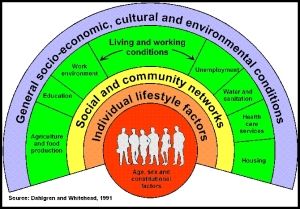The Social Determinants of Health
The SCHI Healthy Settings programme is focussed on addressing the social determinants of health. The World Health Organisation defines these as “the conditions in which people are born, grow, live, work and age. These circumstances are shaped by the distribution of money, power and resources at global, national and local levels”. These issues affect the every day lives of Malawians living in rural and urban areas however they are often overlooked in the development and management of health services (both preventative and curative) due to limited resources and specific focus on particular diseases.
The SCHI, in partnership with the Ministry of Health is piloting the concept of the healthy settings approach in Chikhwawa District. The concept of healthy settings is supported by the Health Sector Strategic Plan (2011 – 2016), as a means to address the current limitations of preventive health services at community level and ensure the delivery of the Essential Health Package. Environmental health is key in implementing this system through the District Health Office, particularly the Health Surveillance Assistants who are community based health workers interacting with villages on a daily basis.
Successful improvements in disease prevention have been limited in Malawi in the last 20 years. Despite an understanding that many of the diseases causing morbidity and mortality are preventable, and consistent focus on education and behaviour change at community level, there has been little improvement in many health statistics. This may be due to a number of barriers and challenges at village level many of which have been identified in previous SCHI programmes. These include:
-
Lack of collaboration between community structures – through the decentralised system of government in Malawi there are specific village based committees who are responsible for overseeing development and management through the government and traditional hierarchies. These include Area Development Committees, Village Development Committees, Village Health Committees, etc. However, alongside these accepted structures, there are also groups of volunteers and committees which have been set up by external organisations such as loans committees, agricultural committees, women’s groups, etc. If operating correctly all of these groups should be answerable to the Village Development Committee and traditional leaders. However in reality many of these groups operate in isolation with little information sharing and therefore a lack of community wide development. A thorough analysis of the existing committed and groups and their functions needs to be undertaken to provide a more transparent and effective structure for community dialogue and development.
-
Poor support for villages/communities – In many cases villages do not feel supported by the personnel and structures which are put in place to assist them. for example, health surveillance assistants may not provide the support and services they are employed to give, the village may not feel empowered to approach the water office to repair a broken down supply system. Populations needs to feel empowered and capable of making decisions to affect change in their communities with the support of the government and traditional structures.
-
Ineffective identification of community needs – In many cases the needs of the village/community are based on a single household baseline survey or focus groups discussions in conjunction with records from health centres. However, the needs identified from these data collection exercises are often based on assumption from the community on how an organisation can assist them, and do not include all members of the village but are instead swayed by the needs and thoughts of leadership. A more effective and objective means which is community driven needs to be used to identify needs without biasing results towards a specific outcome. By looking at all social determinants of health and several means of data collection for comparison this can be addressed.
-
Community networking and bonding – the importance of social capital is often neglected in the assessment of villages for intervention programmes. For example, the presence of separate communities within villages with different needs, and the need for bonding within villages to move towards a common goal are keys to successful health improvements. However these issues are not often assessed at baseline to determine their impact on any proposed interventions. This has to be included on a regular basis in any community development to ensure sustainability.
With all of this in mind, the SCHI will be implementing a healthy settings programme which will aim to tackle the social determinants of health and take into consideration these key obstacles to village development throughout the programme.

